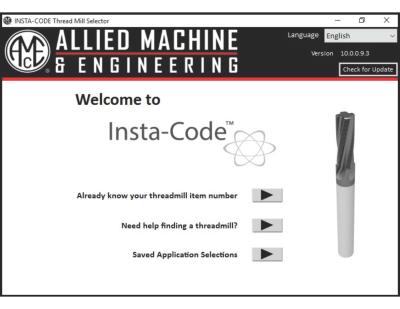
Allied Machine & Engineering announces its new Insta-Code thread mill programming software, now available for download. The software is designed to save shops valuable production time by simplifying thread milling program setup and providing pre-production data for planning purposes.
With the cycle time calculator built into the program, Insta-Code allows machinists to preview actual cycle times. If the thread mill item number is known, the software can create a program instantly. Insta-Code can also suggest the best thread mill product for an application, as well as provide internal and external thread programs for multiple machine controller types including Mazatrol, Siemens, Heidenhain, FANUC or ISO G-Code.
For those without internet access on their shop floors, the new Insta-Code thread mill programmer can be downloaded to a USB flash drive for direct installation onto computers. The ability to save custom programs and transfer them to various locations can also reduce production time.
Online version:
- Generates thread mill G-Code programs
- Available online 24/7
- No log-in required
- No updates needed
- Easily share program code
- Supported on all browsers
Download version:
- Creates program code for multiple machine platforms
- Suggest a thread mill based off of application details
- Provides estimated cycle time for improved production
- Available for use offline.
- Available in multiple languages.
- Download and open Allied_Machine_Insta-Code.zip, open, then click on setup.exe to install.
- One click updates are available for online computers.
Offline version updates:
- Update your offline Insta-Code software
- Click here to download an updated .zip file, then transfer to the offline computer. Click "Check for Update" in your Insta-Code software and navigate to the downloaded zip file.
- This allows you to keep all of your saved programs.
Contact Details
Related Glossary Terms
- flash
flash
Thin web or film of metal on a casting that occurs at die partings and around air vents and movable cores. This excess metal is due to necessary working and operating clearances in a die. Flash also is the excess material squeezed out of the cavity as a compression mold closes or as pressure is applied to the cavity.
- gang cutting ( milling)
gang cutting ( milling)
Machining with several cutters mounted on a single arbor, generally for simultaneous cutting.
- milling
milling
Machining operation in which metal or other material is removed by applying power to a rotating cutter. In vertical milling, the cutting tool is mounted vertically on the spindle. In horizontal milling, the cutting tool is mounted horizontally, either directly on the spindle or on an arbor. Horizontal milling is further broken down into conventional milling, where the cutter rotates opposite the direction of feed, or “up” into the workpiece; and climb milling, where the cutter rotates in the direction of feed, or “down” into the workpiece. Milling operations include plane or surface milling, endmilling, facemilling, angle milling, form milling and profiling.
- milling machine ( mill)
milling machine ( mill)
Runs endmills and arbor-mounted milling cutters. Features include a head with a spindle that drives the cutters; a column, knee and table that provide motion in the three Cartesian axes; and a base that supports the components and houses the cutting-fluid pump and reservoir. The work is mounted on the table and fed into the rotating cutter or endmill to accomplish the milling steps; vertical milling machines also feed endmills into the work by means of a spindle-mounted quill. Models range from small manual machines to big bed-type and duplex mills. All take one of three basic forms: vertical, horizontal or convertible horizontal/vertical. Vertical machines may be knee-type (the table is mounted on a knee that can be elevated) or bed-type (the table is securely supported and only moves horizontally). In general, horizontal machines are bigger and more powerful, while vertical machines are lighter but more versatile and easier to set up and operate.

